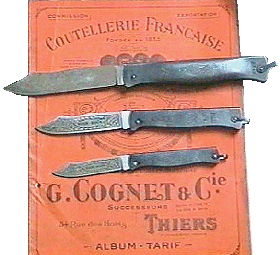Description:
Douk Douk
The firm of Gaston Cognet and company created the Douk Douk in the town of Thiers in 1927.
Gaston's grandson Pierre Cognet is now the director of the factory and is assisted by his father Guy Cognet (the previous director for the past 50 years).

The original knife has a 4-inch blade and is now accompanied by small and large knives with 3 and 5-inch blades. The 4-inch blade remains the best seller.
The shape of all three knives is similar although the handle of the large knife is swollen in the middle.
The handle is stamped with the image of a sorcerer called "Douk Douk." He is a God of doom in French Polynesia.
The handle is made of sheet steel folded into a U shape and encloses a spring which holds the blade open or closed. The whole knife is assembled with two pins. One forms the blade pivot and the other secures the spring and the steel loop for the lanyard.
Although the Douk Douk is an industrial production, all its assembly and checks have been made by hand since 1927.
The blade shape is a Turkish clip: a cross between a Bowie and a Scimitar. The steel is 1075, hot drop forged and integral hollow ground with a Rockwell hardness of HC 52-53.

Douk Douks were made in their thousands for the former French colonies, especially for the Pacific islands. However they also found their way to the North African countries (Morocco, Algeria, Tunisia etc.) where they were very popular. In some African countries, the word "Douk Douk" is synonymous with "knife." The knife came back to Europe after the Algerian war of independence when many Algerians moved to France.
Some variants of the Douk Douk are:
El Baraka, produced for northwest Africa.
Tiki produced for Oceana and decorated with a Tahitian idol.
Squirrel produced for the French market.
Why was the knife so successful?
Douk Douks were and are inexpensive, but the steel is of premium quality. The temper and the grind are so good that Algerians even used the Douk Douk for shaving instead of a razor.
They are very easy to re-sharpen.
The handle covers its spring, so that it cannot harm the user if the spring explodes.
The Douk Douk can fit easily in a pocket or a wallet and can complete a medical or survival kit.
Many people may regret the fact that Douk Douk is not a lock back. But, without the lock (yet with a secure spring), the knife is internationally legal.
The medium size comes in a stainless version for mariners and deep forest explorers such as Geoffrey De Gentille who used the Douk Douk in the Congo. The Douk became the main knife of the Pygmy tribe who worked with him over the years. Pygmies used a lot machetes and the Douk. Their Douks were sharpened one side only, like a chisel.
Cheap but excellent material quality; when you need a knife for hard chores and you won't mind losing or destroying it, call for a Douk Douk!
Manufactured Date Stamp : |



